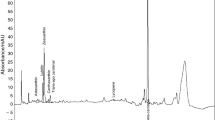Abstract.
The ability of different cooking oils to withstand oxidation was investigated in relation to their native antioxidant capacity [measured as the Ferric Reducing/Antioxidant Power (FRAP) value]. The antiperoxidation effect of the presence of the Chinese herbs, du-zhong (Cortex Eucommia ulmoides) and ginseng (Panax ginseng C.A. Mayer) in corn oil was also investigated over 26 days’ storage at 55°C. Results showed that sesame oil had the highest FRAP value (803 μM), followed by canola oil (400 μM), and sunflower, peanut, corn and olive oils (100–153 μM). Oils with higher intrinsic antioxidant content showed higher resistance to oxidation, although this was not statistically significant. Corn oil to which was added the herbs du-zhong, ginseng or both had increased resistance to oxidation (conjugated diene level and lipid peroxide formation) over 26 days. FRAP values of the oil/herb mixtures decreased during this time, implying utilisation of herbal antioxidants. Results have implications for increasing the shelf-life and usage time of cooking oils by addition of herbs which can increase resistance of the oil to oxidation. Results have implications also for health, as it is possible that ingestion of these herbs could increase resistance of polyunsaturated fatty acids of cell membranes and lipoproteins to oxidation within the body.



Similar content being viewed by others
Abbreviations
- Abbreviations: FRAP::
-
Ferric Reducing/Antioxidant Power (FRAP);
- LPO::
-
Lipid peroxidation (LPO).
References
Shahidi F (2000) Antioxidants in food and food antioxidants. Nahrung 44: S158–S163
Gugliucci A, Menini T (2002) Three different pathways for human LDL oxidation are inhibited in vitro by water extracts of the medicinal herb Achyrocline satureoides. Life Sci 71: 693–705
Ping C, Anping H (eds) (1998) Chinese herbs and compatibility. Science Press, Beijing, China, pp 2–20
Chung WY, Yow CMN, Benzie IFF (2003) Assessment of membrane protection by traditional Chinese medicines using a flow cytometric technique: Preliminary findings. Redox Rep 8: 31–33
Ng TB, Liu F, Lu Y, Cheng CH, Wang Z (2003) Antioxidant activity of compounds from the medicinal herb Aster tataricus. Comp Biochem Physiol: Toxicol Pharmacol 136: 109–115
Hsieh CL, Yen GC (2000) Antioxidant action of du-zhong (Eucommia ulmoides Oliv.) toward oxidative damage in biomolecules. Life Sci 66: 1387–1400
Yen GC, Hsieh CL (2000) Reactive oxygen species scavenging activity of du-zhong (Eucommia ulmoides Oliv.) and its active compounds. J Agri Food Chem 48: 3431–3436
Gillis CN (1997) Panax ginseng pharmacology: A nitric oxide link? Biochem Pharmacol 54: 1–8
Yen GC, Hsieh CL (2003) Inhibitory effect of Eucommia ulmoides Oliv. on oxidative DNA damage in lymphocytes induced by H2O2. Teratogen Carcinogen Mutagen Suppl 1: 23–34
Kitts DD, Wijewickreme AH, Hu C (2000) Antioxidant properties of a North American ginseng extract. Mol Cell Biochem 203: 1–10
Yun TK (2003) Experimental and epidemiological evidence on non-organ specific cancer preventive effect of Korean ginseng and identification of active compounds. Mutat Res 523–524: 63–74
Benzie IFF, Strain JJ (2000) Ferric Reducing/Antioxidant Power Assay: Direct measure of total antioxidant activity of biological fluids and modified version for simultaneous measurement of total antioxidant power and ascorbic acid concentration. In: Packer L (ed) Methods in enzymology, vol. 299. Academic Press, Orlando, pp 15–27
Union of Pure and Applied Chemistry (1987) Standard methods for the analysis of oils, fats, and derivatives. 7th rev. Blackwell Scientific Publications, Boston, CO
Moore K, Roberts LJ (1998) Measurement of lipid peroxidation. Free Rad Res 28: 659–671
Kolesnichenko AV, Zykova VV, Grabelnych OI, Koroleva NA, Pobezhimova TP, Konstantinov YM, Voinikov VK (2001) Influence of CSP 310 and CSP 310-like protein from cereals on mitochondrial energetic activity and lipid peroxidation in vitro and in vivo. BMC Plant Biol 1: 1–10
Viljanen K, Kylli P, Hubbermann EM, Schwarz K, Heinonen M (2005) Anthocyanin antioxidant activity and partition behavior in whey protein emulsion. J Agric Food Chem 53: 2022–2027
Benzie IFF, Szeto YT (1999) Total antioxidant capacity of teas by the ferric reducing/antioxidant power (FRAP) assay. J Agric Food Chem 47: 633–636
Hashim YZ, Eng M, Gill CI, McGlynn H, Rowland IR (2005) Components of olive oil and chemoprevention of colorectal cancer. Nutr Rev 63: 374–386
Aligiannis N, Mitaku S, Tsitsa-Tsardis E, Harvala C, Tsaknis I, Lalas S, Haroutounian S (2003) Methanolic extract of Verbascum macrurum as a source of natural preservatives against oxidative rancidity. J Agric Food Chem 51: 7308–7312
Beddows CG, Jagait C, Kelly MJ (2000) Preservation of alpha-tocopherol in sunflower oil by herbs and spices. Int J Food Sci Nutr 51: 327–339
Vitaglione P, Fogliano V (2004) Use of antioxidants to minimize the human health risk associated to mutagenic/carcinogenic heterocyclic amines in food. J Chromato B: Anal Technol Biomed Life Sci 802: 189–199
Acknowledgment
The authors wish to thank The Hong Kong Polytechnic University and Macao Science & Technology Development Fund for funding this work.
Author information
Authors and Affiliations
Corresponding author
Rights and permissions
About this article
Cite this article
Cheung, S.C.M., Szeto, Y.T. & Benzie, I.F.F. Antioxidant Protection of Edible Oils. Plant Foods Hum Nutr 62, 39–42 (2007). https://doi.org/10.1007/s11130-006-0040-6
Received:
Accepted:
Published:
Issue Date:
DOI: https://doi.org/10.1007/s11130-006-0040-6




